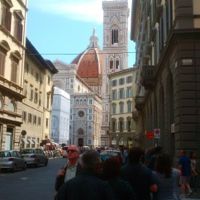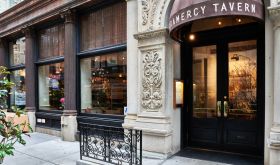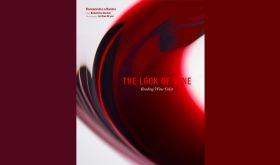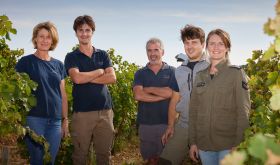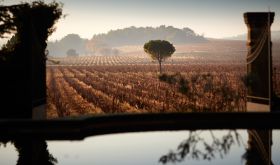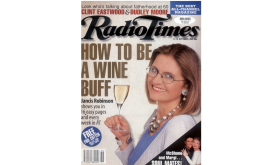This article was also published in the Financial Times.
As the pianist swung into a Scott Joplin number in the Winter Garden restaurant of the St Regis Hotel in Florence and the sommelier poured our first glass of a Castello di Ama Chianti Classico Riserva 2008, my friend lent forward and said somewhat conspiratorially, 'I think the changes in my city's restaurants since you were here four years ago can best be described in two words, "alto basso", from top to bottom.'
He explained the use of this phrase by adding that for as long as he could remember, Florentine restaurants tended to cover the middle range extremely well by serving the best local ingredients, simply prepared, Now, he explained with considerable civic pride, there are far more places, as many as in other cities that are casual and inexpensive, but several others that are far more ambitious.
Certainly, the plush surroundings of the St Regis were in complete contrast to my €7 lunch, where I had collected a plate of freshly sliced buffalo mozzarella, promptly laced with tomatoes, basil and olive oil, and enjoyed all this despite only a plastic knife and fork plus an unobstructed view of more chefs getting ready for the dinner service.
But it was the location of this simple meal, on the first floor of the Central Market, the Mercato Centrale, by the church of San Lorenzo, which was even more exciting than the food. While the ground floor of the market has been home since 1872 to the display of chickens, veal, and fish – stalls that are currently cheek by jowl with punnets of apricots, cherries and borlotti beans – to enthusiastic local chefs, its first floor was something of a backwater. No longer.
On 23 April 23, the plans of restaurateur Umberto Montano finally bore fruit and the example set by Barcelona's Santa Caterina and London's Borough Market was transferred into this ornate Italian setting.
The large floor has been broken down into sections with defined cooking and preparation areas constructed for the region's top cooks and producers, with the central area taken up by the all-important bar, coffee machines and communal seating area. So it is very easy to wander round and take one's pick from the bread and pâtisserie of David Ledu; the cheeses of Franco Parola; or fish prepared by Maurizio Sapdini and Paula Rosellini; or just to wander around with an ice cream made by Christian Beduschi. A visit here is an immediate food immersion into Florence for visitors of any age and in any number.
My personal re-entry into this city, which was to involve a simple pasta dish, a serving of 'trippa Fiorentina', combined with a view of the kitchen, took place at the Trattoria Sostanza just north of the Arno.
The trattoria's narrow glass front door conveys a lot of information. It has been in business since 1869; it does not take credit cards; during the summer it is open on Saturday; and the menu, on a single sheet of paper, reveals its unchanging approach and obvious great value. Their first courses are under €10. Most main courses, including their signature dish, a tortino di carciofi, a creamy artichoke tart, are around €15-17, other than the bistecca alla Fiorentina ordered with great enthusiasm by the tables of Filipinos and Japanese on either side of us.
The dining area is tiled, its walls hung with paintings and slightly more recent photos of great cyclists, footballers and singers, with an open kitchen at the far end. Service is swift and the food exemplary: the chicken broth for the pasta was uplifting and the tripe served in a shallow pan so that neither the rich tomato sauce nor the grated Parmesan overwhelmed the deliciously tender meat.
The contrast between this trattoria and the style of La Bottega del Buon Caffè, a 10-minute taxi ride towards Fiesole from the centre, where we served a complimentary glass of French fizz as we sat down, could not have been greater.
This intimate, candle-lit restaurant seats no more than 30 and houses a cellar that will appeal to both French and Italian wine lovers. It is managed by Saverio Roseni, a man of charm who came running after the women in our party with posies of freshly picked flowers, and its kitchen is run by the talented Antonello Sardi.
Although Sardi is modern and precise in style and presentation, he resolutely sticks to the local habit of writing only a brief but intriguing menu. Highlights included three well thought out combinations: diced beetroot with octopus; taglierini with anchovies and crisp breadcrumbs; and an exquisite agrodolce (bitter/sweet) sauce that sensitively complemented a rich duck breast.
A year ago the management of the St Regis brought in the esteemed chef Valeria Piccini from Da Caino restaurant in the Maremma, to breathe warmth into their grand dining room. Having met the magnificent Piccini, I can think of no one more suitable to do the job. But although certain dishes are very good, particularly her papardelle with pigeon ragu and the beef tartare, there is still the need in the dining room for a personality of Piccini's stature to bring the whole place to life.
Il Mercato Centrale Central Market, Piazza del Mercato Centrale, Florence
Trattoria Sostanza Via del Porcellana 25, Florence; tel +39 55212691
La Bottega del Buon Caffè Via Antonio Pacinotti 40, Florence; tel +39 5535677
The Winter Garden St Regis Hotel, Piazza Ognissanti 1, Florence; tel +39 5527163770
Desinare is Florence's new stylish cookery school.

